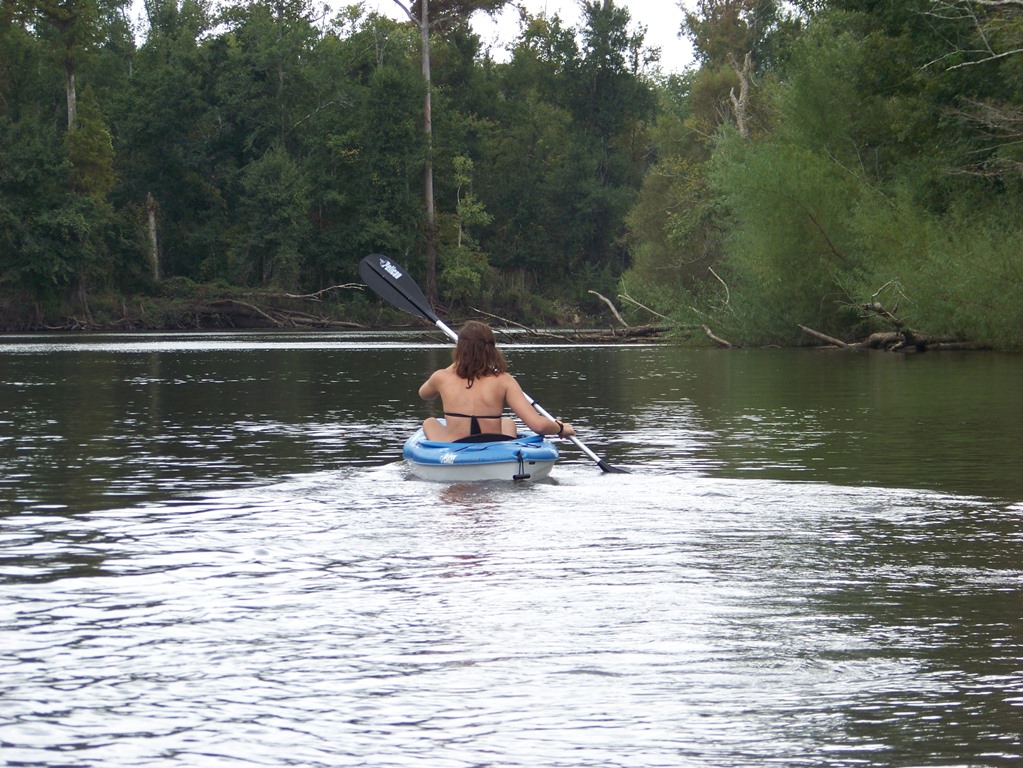
by Rick O'Connor | Sep 21, 2015
A couple of years a few agencies in south Alabama put together something they called the Alabama Birding Trail. It was a relatively simple idea really – they developed a brochure that marked different locations where visitors could enjoy birding in the two county area. They had large signs posted at those locations so that the visitor knew they were at the correct location. There seemed to be a need for this with some vacationers and they provided… It was a big success. More and more visitors were using the trail. It became so popular they that conducted a survey and found that about 40% of the visitors who come to our Gulf coast are looking for outdoor/wildlife adventures to do. Ecotourism is becoming more and more popular.
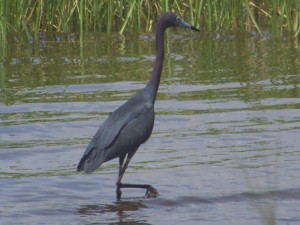
A heron exploring a local salt marsh for food.
Photo: Molly O’Connor
The panhandle is no different. Each year hundreds of thousands to millions of visitors come to our beaches. There is no doubt that we have some of the most beautiful beaches in the world, and they are a huge draw, but we have a lot of outdoor adventures to provide them as well. From scalloping in St. Joe, to snorkeling the jetties in Panama City, to fishing in Destin, to paddling in Navarre, to dolphin cruises in Pensacola the panhandle provides a wide variety of activities for both the local residents and visitors to enjoy – and employment for many.
So what does this have to do with estuaries?
Well, for most of these businesses a healthy wildlife population is needed. A dolphin cruise with no dolphin is not much. Visitors coming to stay on our beaches will certainly enjoy the white sand and emerald waters. They will return home with pictures and stories of how beautiful it was and how they hope to return – but if they saw a sea turtle that week, or went snorkeling and found thousands of tropical fish to view, or kayaked over a lagoon and found horseshoe crabs or stingrays… the stories get better and their urge to return grows. Wildlife and healthy estuaries are good for business – for everyone.
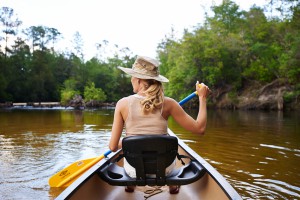
Paddling Blackwater River.
Photo: Adventures Unlimited
In 2014 the Escambia and Santa Rosa county extension offices launched a program called Naturally EscaRosa to help both locals and visitors locate both agritourism and ecotourism businesses in the two county area. The sight provides information on camping, hiking, fishing, sailing, snorkeling, biking, wildlife viewing, and farm tours (of which the popularity is growing across the country). Most of these depend on a healthy bay. Health advisories, fish kills, and loss or degradation of habitat are all problematic for the ecotourism industry. Snorkeling and finding no scallops, paddling over a lagoon and seeing no wildlife, or a slow fishing day on a charter will obviously hurt business – and remember the spin-off’s such as hotels and restaurants as well.
Estuaries have certainly benefitted this industry. From providing a nursery ground for the species we are trying to view or catch, to paddling through a peaceful salt marsh to get away from the hustle and bustle of everyday life, estuaries have been an important part of our lives. And the sunsets… don’t forget the sunsets.
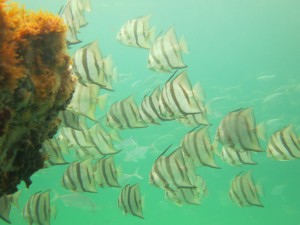
Spadefish on a panhandle snorkel reef.
Photo: Navarre Beach Snorkel
We encourage all locals and visitors to get out and enjoy the beauty of our bays. As the beach season ends the crowds are down, the weather is cooler, and it is a perfect time to venture out. For information about different activities in your area contact your local tourism board, or your county extension office.
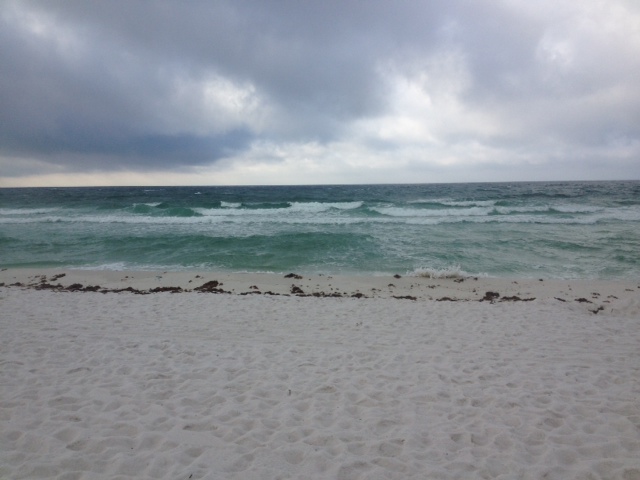
by Rick O'Connor | Apr 17, 2015
As we left the winter months and headed into spring I was expecting a lot of new blooms, new animal tracks, and more live encounters with wildlife… and then the rain began. I do not know if the entire panhandle has been getting what Pensacola has but the rain has been nonstop for over a week now. I track rain days for a water quality project and for the first three months of 2015 the number of days during a month where it rained was between 23-30%. We are about half way through April and so far it has rained 61% of the days. WELL… rain or shine we will make this hike and see what is happening on our barrier island.
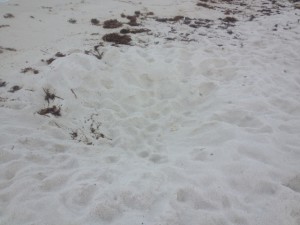
Hole left by a sand castle architect. These can be problems for wildlife and rescue vehicles. Photo: Rick O’Connor
The first thing I noticed when I began the trip along the Gulf was this large hole left by a sand castle architect. These can be problematic for some forms of wildlife, including sea turtles, but they can also be a problem for rescue and turtle watch vehicles. Please enjoy the beach and make awesome sand castles, but when you are finished please fill the hole.
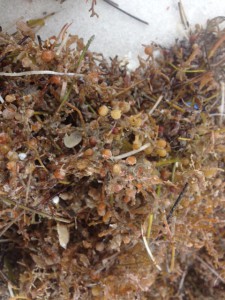
Sargassum is floating form of brown algae. Notice the “air bladders” (pneumatocyst) Photo: Rick O’Connor
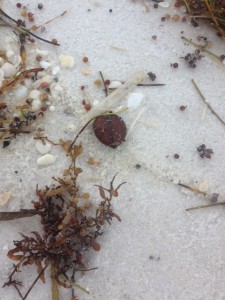
A tropical seed commonly referred to as a sea bean. Photo: Rick O’Connor
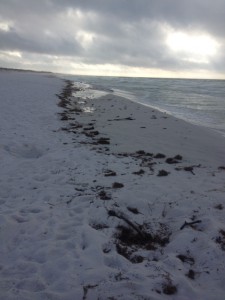
The line of seaweed and debris along the surf zone is called wrack. Photo: Rick O’Connor
The line of seaweed and debris that washes ashore during storms is called the wrack. For the most part it is natural material and provides the nutrients needed for many of the high energy shoreline plants to grow. Many of the beach animals found in the berm and primary dune depend on this wrack as well. Many locals and visitors find this material and eye sore and, at times, producing an unpleasant odor. But this material is an important part of the beach ecology. Sargassum is a drifting member of the brown algae, sometimes called “gulfweed”. It possess small air bladder structures called pneumatocysts that allow it to remain at the surface of the open Gulf where the sunlight is. These large offshore mats of Sargassum have been targets for local fishermen for decades. Many small invertebrates live in these drifting mats and these are targets for small fish, which in turn are targets for even larger sport fish. They are also the hideaway for sea turtle hatchlings. When the little guys head for the Gulf after hatching this is where they are heading. Large ocean currents, including the Gulf Stream, push Sargassum into large mats in the middle of the open ocean. The area within the Atlantic where this happens in known as the Sargasso Sea. If you get a chance this summer, grab a small hand net and mask when the Sargassum is just offshore. Collecting you may find a lot of cool interesting creatures. Sea Beans is a generic word for a variety of tropical seeds that wash ashore in the northern Gulf. Some of these may sprout, including mangroves, but most will not make it through our winters.
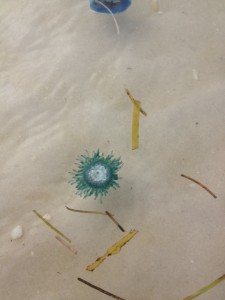
The Blue Button Jellyfish is a tropical cousin of the Portuguese man-of-war. Photo: Rick O’Connor
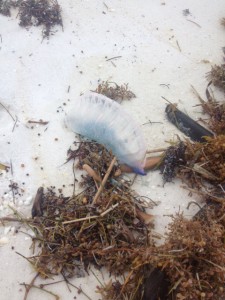
The Portuguese Man-of-War is one of the more venomous jellyfish in Florida waters. Photo: Rick O’Connor.
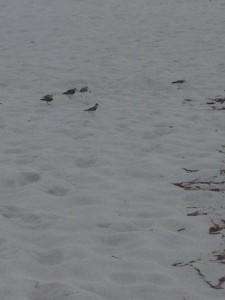
A variety of shorebirds utilize the wrack. Photo: Rick O’Connor
One of the more venomous jellyfish in Florida waters is now making its way onto our shores. The Portuguese man-of-war, named for the many “guns” this animal possess, is well known by locals but not so much by some of our visitors. The man-of-war is actually not one animal but a colony of sedentary polyp jellyfish that produce an inflated bag which floats at the surface carrying them across the sea. The dark blue tentacles hang down into the water column where passing fish are stung and consumed. Each of the polyps have connecting stomachs which helps move the food around to the whole colony. The sting of this jellyfish is quite painful and should be avoided. When they arrive life guards will usually fly a purple flag.
Their close cousins, the Blue Button Jelly, is very similar to the man-of-war albeit they are much smaller and the venom is not as potent. They are more tropical and not common along the northern Gulf but in recent years more have been washing ashore; they are here now.
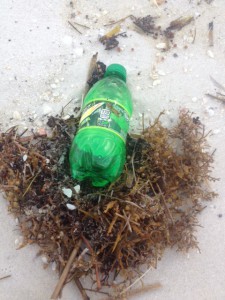
A variety of plastics ends up in the Gulf. Each is a potential problem for marine life. Photo: Rick O’Connor
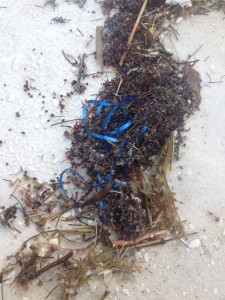
Pieces of plastic ribbon resemble jellyfish tentacles and are frequently consumed by sea turtles. Photo: Rick O’Connor
One of the bigger issues are oceans are facing are discarded plastics. These materials takes years to decompose and are found in all oceans and seas. Even some distant isolated islands have huge piles of this form of marine debris. Plastics can entangle marine organisms or they may actually swallow it, plugging their digestive system and eventually starving them. We encourage locals and visitors alike to help with this problem by taking your trash with you and discarding it in a location where it will not reach the Gulf.
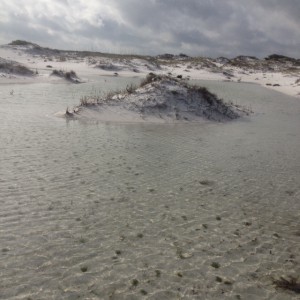
This ephemeral pond formed around a small dune which becomes a temporary island. Photo: Rick O’Connor
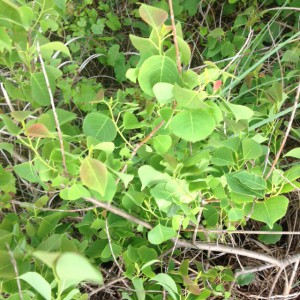
The Chinese tallow is an invasive species the entire state is dealing with. Photo: Rick O’Connor
With the heavy rains of the last week ephemeral ponds have formed on parts of the island. These small pockets of freshwater can be “manna from heaven” for many island residents, particularly the amphibians. I have been hiking this section of Pensacola beach for years, leading field trips for all sorts of groups. I have never seen this Chinese Tallow until today. Also known as the “popcorn tree” due to its unique looking fruit, this plant is listed as an invasive in the state of Florida and is very aggressive. I did not see any others and will seek permission to remove it before it spreads to other dunes and out competes the native plants.
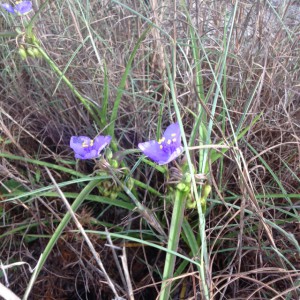
One of the few plants blooming in April, the Spiderwort is a common weed in many lawns. Photo: Rick O’Connor
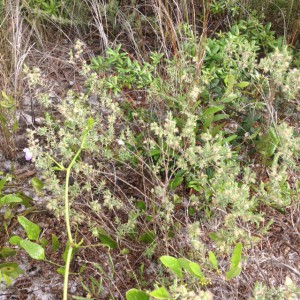
The blossoms of Conradina first appeared in February. They are all but gone this time of year. Photo: Rick O’Connor
I was actually expecting more flowers to be in bloom this month but there were few. The Conradina, which have been in bloom since February, have lost most of its blossoms. The “new kids on the block” are the Spiderwort, the Primrose, the Sandhill Milkweed, and the Devil’s Joint Cactus.
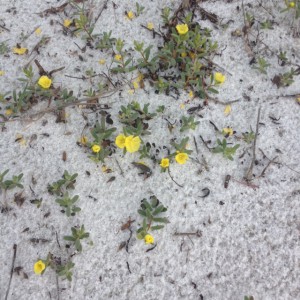
There are a variety of primrose that grow on our barrier islands. They are beginning to bloom now. Photo: Rick O’Connor
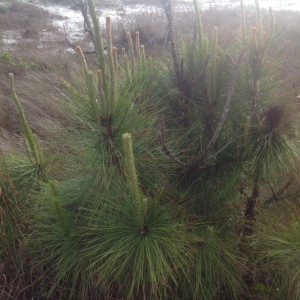
New growth on a pine tree. Photo: Rick O’Connor
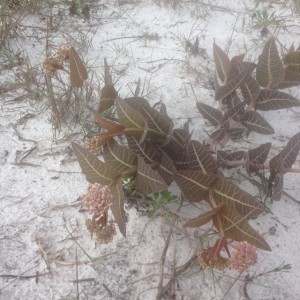
The Sandhill Milkweed. Photo: Rick O’Connor
The Sandhill Milkweed is one of the plants used by the monarch butterfly to gain fuel for their great flight across the Gulf to Mexico. The milky toxic sap of this plant is consumed by the monarch caterpillar but it does not harm it. The chemical toxins therefore become a defense for the monarch and the butterfly has earned the respect of many birds; though it may be a trial and error learning experience.
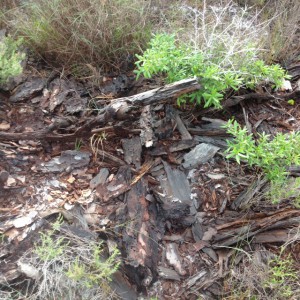
A decomposing log is a microhabitat for many organisms. Photo: Rick O’Connor
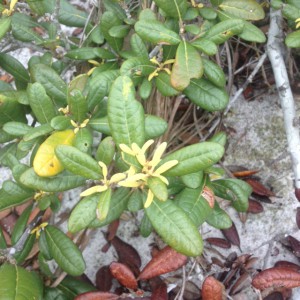
New growth on a live oak. Photo: Rick O’Connor
Most environmental centers, state and federal parks, leave fallen trees where they lie. The tree is actually a storage house of nutrients and full of cavities that can be used by a lot of organisms within the beach community.
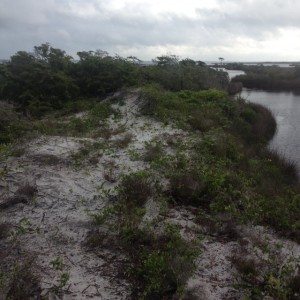
The mysterious “drags” we have seen the last three months were not to be found in April. Photo: Rick O’Connor.
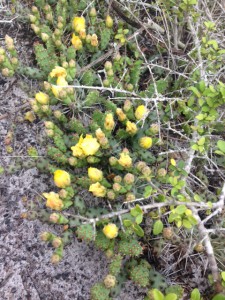
The beautiful yellow bloom of the Devil-Joint cactus. Photo: Rick O’Connor
This month the weather was warm enough for me to venture into the Salt Marsh. Salt marshes are wetlands but differ from swamps in that the dominate plants are grasses, not trees. Our local salt marsh is dominated by two species of grass, the Smooth Cordgrass, and the Black Needlerush. There are many other plants that exist here but these are the most common. This particular marsh is dominated by Black Needlerush. Salt marshes are one of the most productive systems on the planet, producing tons of organic material annually. 90% of the commercially valuable marine species spend part or all of their lives here. There are many unique species to this system as well. Today the water was crystal clear but I saw few fish. I expect as it gets warmer we will see more. It is very possible that with the heavy rains that they have moved to deeper, saltier spots in the Sound.
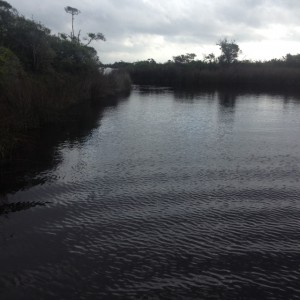
It’s warm enough to enter the salt marsh. Photo: Rick O’Connor
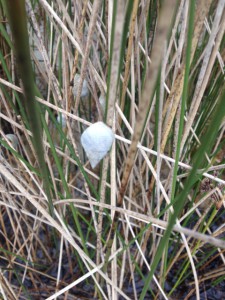
The marsh periwinkle is one of the more common mollusk found in our salt marsh. Photo: Rick O’Connor
The Marsh Periwinkle is an interesting guy. This snail will crawl up the stalks of marsh plants during high tide to avoid predators like blue crab and diamondback terrapins. Both of these predators appear to be on the decline and it will be interesting to see how this impacts the ecology of the marsh. At low tide the periwinkles descend and feed on the organic leaf litter on the muddy bottom.
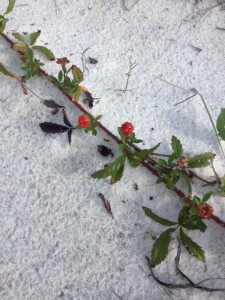
This dewberry has flowered and the dark fruit will be ready next month. Photo: Rick O’Connor
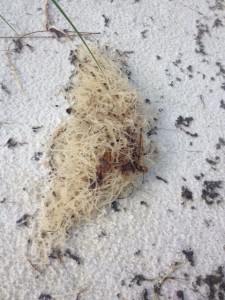
Gracilaria is a common epiphytic red algae growing in our seagrass beds. Photo: Rick O’Connor
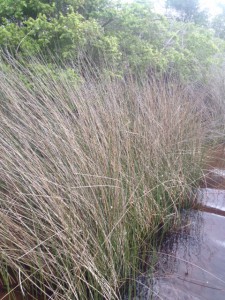
Black Needlerush is one of the two dominant plants of our salt marshes. Photo: Rick O’Connor
Though it has a white appearance, Gracilaria is a member of the red algae group. This algae grows on seagrasses as Spanish moss grows on oaks. The plant is usually kept in check by herbivorous grazers, such as green sea turtles, but in recent decades the number of predators have declined and the amount of nutrient runoff has increased. This has sparked a increase in the growth of this algae and, in some cases, to the determent of the seagrass itself.
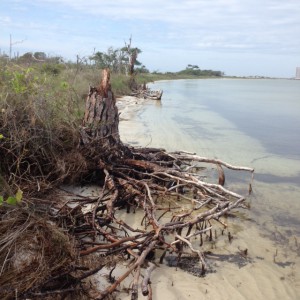
This eroded pine tree gives evidence of the ever changing shorelines of our barrier islands. Photo: Rick O’Connor
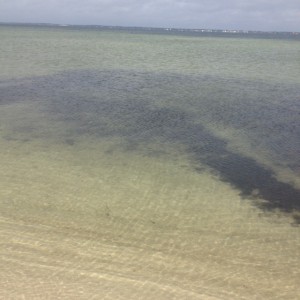
This submerged mound of peat is the remnants of a salt marsh which is now below sea level. Photo: Rick O’Connor
These photos of peat and the eroded tree are indications of a changing shoreline. Due to storms, boat wake, and time, the shoreline of Santa Rosa Island, like all barrier islands, is changing. Peat is actually the remnants of an old salt marsh that has now pass the high tide line and is within the Sound.
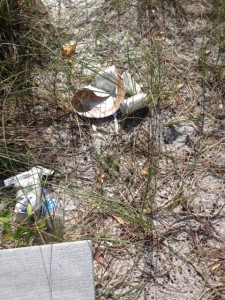
Trash left behind by those enjoying the beach. Photo: Rick O’Connor
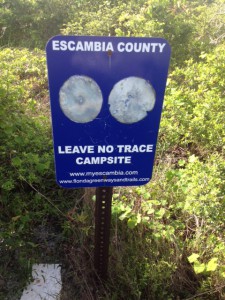
We encourage those who pack it in… to pack it out. Photo: Rick O’Connor
As the weather has warmed and spring break has fallen upon us I have noticed an increase in the amount of trash on this hike, both the Gulf of Sound sides. We encourage locals to take their trash with them and encourage visitors to do the same. Let’s try to keep our waste out of our waters.
I am expecting some animal nesting in May. We will see what we find. Until then.
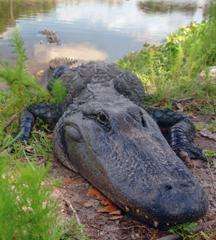
by Rick O'Connor | Apr 10, 2015
The American Alligator is an icon in the state of Florida. Viewed on the program “Swamp People” and as the mascot of the University of Florida, most visitors to our state view this animal more on television than in the wild; but they are certainly there. In need of mates and calories from the lack of eating over the winter, alligators and other reptiles become more active this time of year. Visitors and residents alike should be a little more cautious.
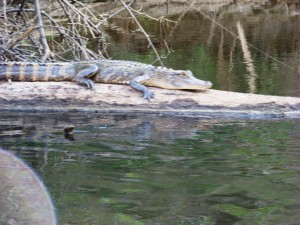
Alligator basking on the Escambia River; photo: Molly O’Connor
Like most predators, alligators seek food that will provide them energy. Generally predators will target prey that will cost them very little energy to capture and kill. Obviously small alligators will feed on small prey but adult alligators feed on smaller prey than many think. Fish, turtles, snakes, small mammals and birds make up the bulk of their diet. If the opportunity presents itself, and they do not have to expend too much energy, alligators will certainly take larger mammals and birds.
For humans the bigger problem has been the loss of pets and livestock. Small dogs are certainly easier prey than a human, and with the loss of habitat encounters with humans and their pets have increased. Since 1948 FWC has estimated about 300 alligator attacks on humans directly, less than 10% of these were fatal. As more alligators are forced into suburban areas more encounters have occurred. In the last 10 years 16,000 nuisance alligator calls have been reported to the FWC. As with other wildlife, like coyotes, many of these animals are living in ditches and other watering holes where they seek fish and turtles. However if we visit such places, particularly with our pets, these animals may certainly make an attempt to grab them. If you feel an alligator is a nuisance and could be a potential problem you can call FWC at (866) FWC-GATOR; (866) 392-4286). Folks should be aware that FWC does not relocate nuisance alligators, they will be destroyed. Currently FWC issues about 7000 permits for alligator control across the state.
A couple of safety notes if you live near waterways with alligators.
- Do not swim in these locations at night; alligators are more active hunters between dusk and dawn
- Try to discard fish remains after cleaning in another location besides the water; if these locations have a few alligators they will certainly learn this habitat and hang around the boat ramp more.
- DO NOT FEED alligators; help us let visiting tourists know this and that it is illegal in our state. Alligators fed by humans will eventually lose their natural fear of us and this could bring on problems.
These are awesome animals. We should better understand their natural history so that we can exist with them. For more information on alligators in your area contact your county extension office.
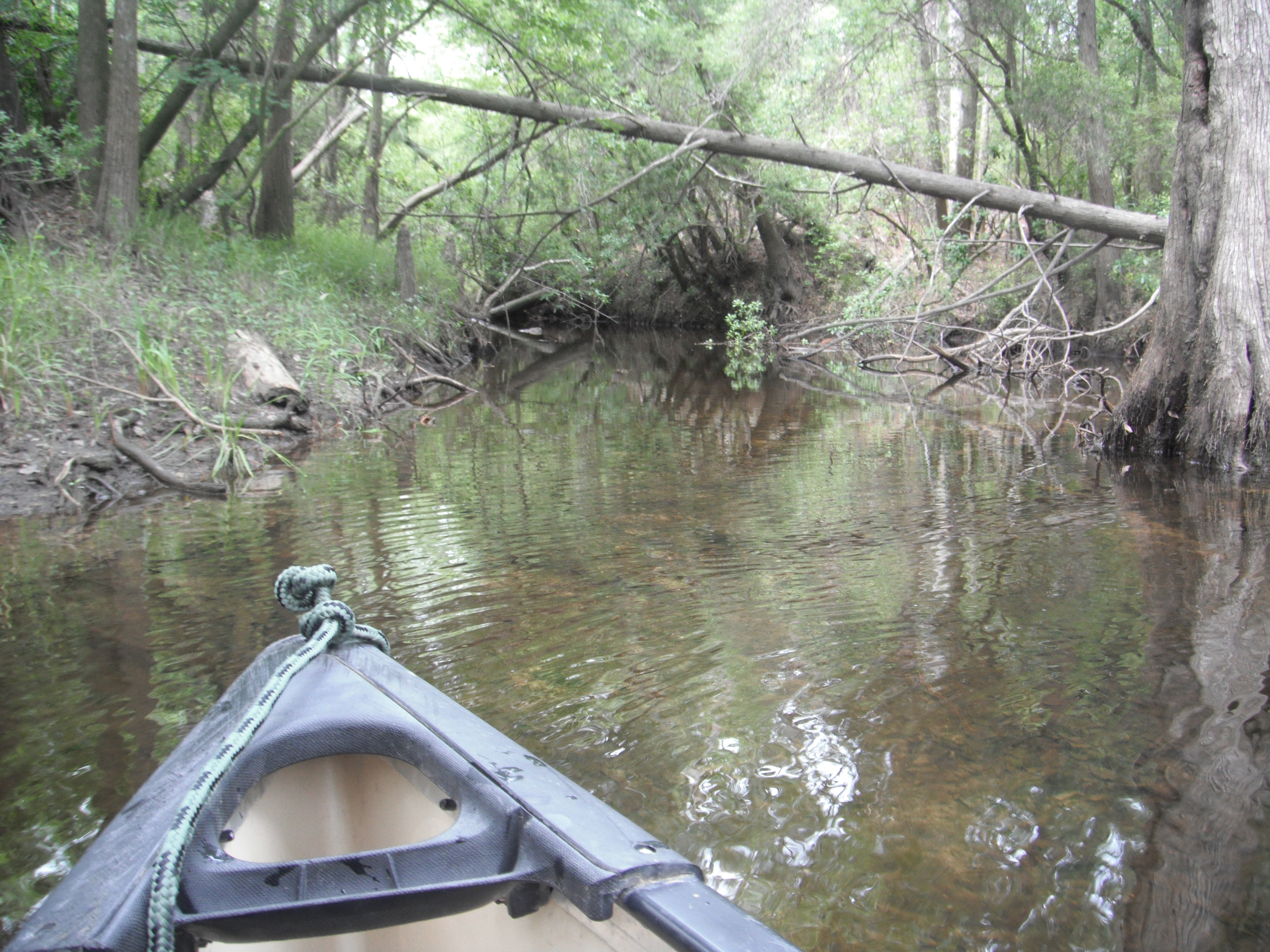
by Carrie Stevenson | Mar 27, 2015
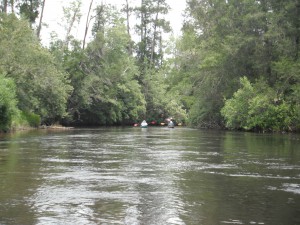
Canoeing in Perdido River Photo credit: Carrie Stevenson
This time of year, many families are looking for ways to entertain their kids during spring break. For those not planning to travel far, our area is full of fun, and often inexpensive, outdoor adventures.
As part of a series of field excursions led by Extension Agents over the past few years, we’ve been able to introduce visitors and lifelong residents of the panhandle to some tremendous natural resources that are right at our back door.
Following are three examples of family friendly trips worth marking off your “Florida bucket list.”
Perdido River: the natural border between Alabama and Florida, the Perdido stretches over 65 miles from its source near Atmore, Alabama and ends up at Perdido Key in the Gulf. Clean, clear, and sandy-bottomed, the Perdido River is a perfect spot to tube, kayak, canoe or paddleboard and several local outfitters can provide equipment. While on the river, you might experience a flyover from a bald eagle, see towering bald cypress, or explore shallow backwater springs and swamps.
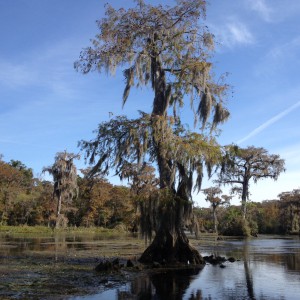
Majestic bald cypress trees serve as wildlife habitat at Wakulla Springs State Park. Photo credit: Carrie Stevenson
Further east is Florida Caverns State Park in Marianna. This region is one of the most biodiverse in the state, with endemic tree species—like the Florida Torreya, found only in three counties in the state—along with many hardwood species found more typically in the central Appalachians. The extensive limestone cavern and spring systems in Jackson County are home to beautiful swimming/diving spots as well as the caverns. The ranger-led tours are excellent, as well as the hiking trails within the park grounds. The cave tour takes about an hour and is mildly strenuous. There are no tours on Tuesday or Wednesday, so keep this in mind when planning a visit.
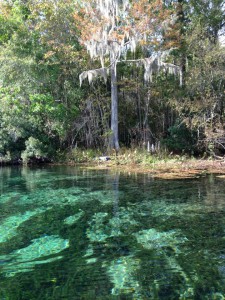
The crystal clear springs of Wakulla are home to alligators and manatees. Photo credit: Carrie Stevenson
At the edge of our district is Hollywood-famous Wakulla Springs. Film site for both “Tarzan” and “Creature from the Black Lagoon”, the spring teems with wildlife year-round. A guided tour via pontoon boat will bring you up close to manatees, alligators, ospreys, anhingas, and large herons. Hiking trails, a swimming hole, and the historic lodge and restaurant are open to visitors as well. The nearby Chipola River is also a beautiful spot to paddle.
Every county in the Florida panhandle has tremendous water resources, from the Gulf to inland rivers and even waterfalls. Take time to explore on your days off this spring!

by Carrie Stevenson | Sep 12, 2014
 The UF/IFAS Extension Escambia and Santa Rosa counties and Naturally EscaRosa would like to invite agritour and ecotour providers to the 2014 Agri/Eco-tourism Business Development Conference on November 5-6, 2014. The conference is geared for businesses wishing to enhance and develop their offerings.
The UF/IFAS Extension Escambia and Santa Rosa counties and Naturally EscaRosa would like to invite agritour and ecotour providers to the 2014 Agri/Eco-tourism Business Development Conference on November 5-6, 2014. The conference is geared for businesses wishing to enhance and develop their offerings.
Owners, operators and employees of u-pick operations, fresh produce markets, corn mazes, pumpkin patches, wildlife/bird watching, paddling, camping, fishing, etc. tourism businesses or those considering starting a similar business are invited to attend this event.
The conference will be an exciting blend of informational sessions, hands on activities, and an opportunity to explore local agritourism and ecotourism businesses. The conference will provide important information for new business startups as well as long established companies in the field.
The keynote speaker, Eric Eckl, will provide information on messaging and direct marketing campaigns. Other topics in the educational program include: starting a business, liability, local success stories, liability, staffing, benefits, & healthcare.
The conference will be held at Adventures Unlimited at 8974 Tomahawk Landing, Milton, Florida 32570. The conference begins at 9 am Nov. 5 and runs through the afternoon of Nov. 6, 2014. Conference registration is $25.00, to register go to: http://santarosa.ifas.ufl.edu/agritourism-ecotourism-conference/
For more information on the 2014 Gulf Coast Agritourism & Ecotourism Business Development Conference, contact Chris Verlinde (850) 623-3868 or Carrie Stevenson (850) 475-5230.
by Carrie Stevenson | Mar 1, 2013
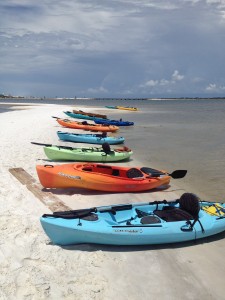 Are you interested in exploring and discovering more about the waterways and wildlife around you? If so, Panhandle Outdoors LIVE may be right up your alley. In 2012, natural resources Extension Agents took over 200 people on trips from Perdido to Apalachicola, and this yearlong series of hiking, boating, and kayaking trips is back by popular demand with 9 new locations. Local experts will provide you with insight into the “real” Florida and take you to places unique to our corner of the world. We promise you’ll go home with a new appreciation for our Florida ecosystems!
Are you interested in exploring and discovering more about the waterways and wildlife around you? If so, Panhandle Outdoors LIVE may be right up your alley. In 2012, natural resources Extension Agents took over 200 people on trips from Perdido to Apalachicola, and this yearlong series of hiking, boating, and kayaking trips is back by popular demand with 9 new locations. Local experts will provide you with insight into the “real” Florida and take you to places unique to our corner of the world. We promise you’ll go home with a new appreciation for our Florida ecosystems!
The expedition schedule is as follows:
March 15: Aucilla River Sinks (Jefferson County)
March 28: The Great Florida Wildlife Trail (Calhoun County)
April 2: Pitcher Plants & Weeks Bay (Baldwin County, Alabama)
May 8: Coastal Dune Lakes (Walton County, Florida)
June 6: Yellow River & Boiling Creek (Santa Rosa County)
August 15: Saltwater Marshes of St. Andrews Bay (Bay County)
September 24: Apalachicola National Estuarine Research Reserve (Franklin County)
October 3: Blackwater River State Forest (Santa Rosa County)
November 15: Seagrasses & Manatees of Apalachee Bay (Wakulla County)
Each day starts at 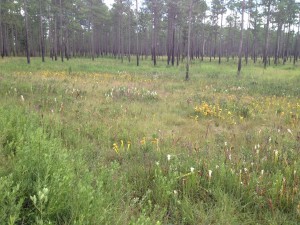 9:30 am central/10:30 am eastern and runs to 4:00 central/5:00 eastern. Please arrive at least 20 minutes early for each trip to ensure the events can start on time. Depending on location, moderate walking, hiking, swimming, and/or paddling may be involved. Lunch, park entry fees, and rentals will be provided for each participant (18 and up only) at a cost of $30.
9:30 am central/10:30 am eastern and runs to 4:00 central/5:00 eastern. Please arrive at least 20 minutes early for each trip to ensure the events can start on time. Depending on location, moderate walking, hiking, swimming, and/or paddling may be involved. Lunch, park entry fees, and rentals will be provided for each participant (18 and up only) at a cost of $30.
Click here for registration and contact information. Space is limited, so register early!
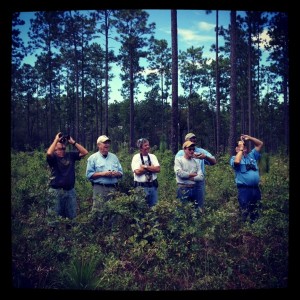
Enjoy exploring Northwest Florida during Panhandle Outdoor Live 2013
Necessary equipment and clothing will vary based on weather and location, but participants should bring sturdy shoes, drinking water, sunscreen, and a camera to each trip. Transportation to each location will be facilitated by carpooling, and some counties may be able to provide transportation.














































